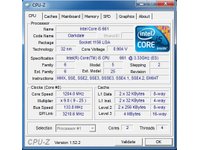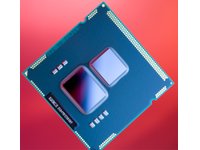Intel Core i5-661: Clarkdale Rings The Death Knell Of Core 2
Clarkdale: Engineering Smarts Behind Marketing’s Mess
The crazy thing is that there’s a ton of intelligence behind Clarkdale, and much of it can be summarized with one word: integration. You see, the entire lineup of Clarkdale CPUs employs two die on a single package. One die consists of the actual processor (32nm), while the other sports a graphics core, integrated memory controller, and PCI Express controller (45nm).
This is, of course, Intel’s first introduction based on its 32nm high-k / metal gate transistor process technology, bringing with it the power and thermal benefits expected from a well-executed transition from 45nm manufacturing. According to Intel, improvements from its first generation of high-k / metal gate transistors include a reduction in oxide thickness from 1nm to .9nm, with gate length dropping to 30nm. As a result, transistor performance increases by more than 22%. Meanwhile, the TDP for all Clarkdale-based desktop processors is 73W, except for the Core i5-661 rated at 87W.
All of the Clarkdale-based Core i5, Core i3, and Pentium processors are dual-core models with 32KB of L1 data cache and 32KB of L1 instruction cache per core, 256KB of L2 cache per core, and up to 4MB of shared L3 cache. This is decidedly a descendant of the Nehalem architecture, which was designed from the get-go for modularity. We'll see that flexibility expand in the other direction in Q1 of this year with Gulftown (six-core, 32nm) and Nehalem-EX (eight-core, 45nm).
The 32nm processor die communicates across a multi-chip package interface, which we’ve had described to us as a very QPI-like bus. And while Intel isn’t talking about the specifications of that inner-package connection, we can assume it’s more tunable than the QPI implementation used to connect Bloomfield and X58 Express, since it doesn’t have to go external.
The second die is, as mentioned, manufactured at 45nm and includes the three critical components mentioned above—basically, everything you would have found in a traditional northbridge.
Intel’s memory controller is a dual-channel design supporting DDR3 memory at speeds of up to 1,333 MT/s, totaling up to 21 GB/s with DDR3-1333 installed. Depending on the motherboard, maximum capacity will differ. However, the processors themselves support up to 16GB.


The Clarkdale CPUs also include 16 lanes of PCI Express 2.0 on-package, just like Lynnfield (of course, Lynnfield’s are actually on the CPU die, rather than on a neighboring die). Now, if you use a Clarkdale chip on an H55- or H57-based motherboard, you’ll be limited to a single 16-lane link for graphics. If, however, you use a Lynnfield processor (a Core i5-750, for example) on an H55- or H57-based motherboard, you’ll at least have access to a pair of x8 PCI Express 2.0 slots. This is interesting because Intel’s datasheets claim Clarkdale processors at least have the ability to divide on-package PCI Express into a pair of x8 slots when used on a P55-based board. If that’s the case, then the H55/H57/Clarkdale combination is artificially prevented from supporting CrossFire or SLI, suggesting gaming enthusiasts should stick with their P55 platforms wherever possible.
Get Tom's Hardware's best news and in-depth reviews, straight to your inbox.


According to Intel, H55/H57 aren't being aimed at the enthusiasts, so it makes sense to validate with a single x16 PCIe slot. For anyone looking to use a dual PCIe x8 arrangement, the company officially recommends going with P55 using either Clarkdale- or Lynnfield-based processors.
Finally, there’s the graphics core to discuss—we’ll get into that in more depth shortly.
Telling Them Apart
What makes the new Core i5s different from the Core i3s and the lone Pentium?
| Intel's Clarkdale Lineup: In Detail | |||||||
|---|---|---|---|---|---|---|---|
| Model | CPU Clock | Max Turbo | Cores/Threads | HT/Turbo | L3 Cache | GPU Clock | DDR3 |
| Core i5-670 | 3.46 GHz | 3.73 GHz | 2/4 | Yes/Yes | 4MB | 733 MHz | 1,333 MT/s |
| Core i5-661 | 3.33 GHz | 3.6 GHz | 2/4 | Yes/Yes | 4MB | 900 MHz | 1,333 MT/s |
| Core i5-660 | 3.33 GHz | 3.6 GHz | 2/4 | Yes/Yes | 4MB | 733 MHz | 1,333 MT/s |
| Core i5-650 | 3.2 GHz | 3.46 GHz | 2/4 | Yes/Yes | 4MB | 733 MHz | 1,333 MT/s |
| Core i3-540 | 3.06 GHz | - | 2/4 | Yes/No | 4MB | 733 MHz | 1,333 MT/s |
| Core i3-530 | 2.93 GHz | - | 2/4 | Yes/No | 4MB | 733 MHz | 1,333 MT/s |
| Pentium G6950 | 2.8 GHz | - | 2/2 | No/No | 3MB | 533 MHz | 1,333 MT/s |
Core i5 features Hyper-Threading and Turbo Boost technology (just remember that Lynnfield-based Core i5s do not include Hyper-Threading). One model employs a 900 MHz graphics core, and the other models run with a 733 MHz GPU. You can tell these chips apart from the Lynnfield-based models by their model designators: Lynnfield populates the i5-700 series, while Clarkdale exists in the i5-600 series.
Core i3 maintains Hyper-Threading, giving you the quad-threaded dual-core CPU, but sheds Turbo Boost, locking you in to one frequency. Both models employ a 733 MHz graphics core. Fortunately, there aren’t any other architectures overlapping Core i3; they’re all Clarkdales.
Clarkdale-based Pentiums lose Hyper-Threading and Turbo Boost. The graphics engine slows down to 533 MHz. But at this point, you’re talking about a sub-$90 part. Because there exists a long list of Pentium processors centering on different cores, right now it’s best to remember the G6950 model name, as it’s the only Clarkdale-based model and the only Pentium to drop into LGA 1156 platforms.
Current page: Clarkdale: Engineering Smarts Behind Marketing’s Mess
Prev Page Introduction Next Page Accelerating Encryption: AES-NI-
Zoonie Well... I think that takes care of the dreaded "But can it play Crysis?" question regarding its GMA :D :P :PReply -
eklipz330 can i ask why you teased us at the end with the 4.5ghz OC but didn't include them in the benchmarks? =Reply -
cangelini xc0mmiexVideo on page 1 not working ... "This is a private video..."Reply
Fixed! Had to keep it private pre-launch :) -
I really like the improvements Larrabee brought about....not! I do like the fact they are making progress but they really need to skip ahead a few generations or buy out some other company to design a GPU for themselves.Reply
-
gkay09 ^ Many more reasons to buy AMD Phenoms II X4 in the mid-range segment...Reply
Only drawback with the AMD CPUs is the power consumption, that I feel can be brought down with slight undervolting... -
dtemple I'm looking to upgrade from my Athlon X2 @ 2.7GHz because I do more with the computer now than I did before - sometimes I'll play a game while my TV tuner is recording from my cable signal, and having more cores would help these multiple tasks run more smoothly.Reply
I was waiting until the Clarkdale-based i5 launched, thinking it would be a quad-core that was more competitively priced against the Phenom II X4, but it looks like a Phenom II X4 is my only option to get more cores for less money.
The only good news coming out of this launch is that LGA1156 is not changing for the Clarkdale chips, so it looks to be the most future-proof platform to upgrade to, if one was so inclined. I'm personally going with a Phenom II since I can get one without changing motherboards. This is one of the more disappointing launches in the last year or so. -
cangelini eklipz330can i ask why you teased us at the end with the 4.5ghz OC but didn't include them in the benchmarks? =Reply
We have another overclocking piece planned--I wanted to get a Core i3, at least, to include :) -
I would love to see what GTA IV would do do the dual cores in gaming! I do know that its a bear of a game on the CPU and it would truly show off if hyperthreading could actually make a major difference.Reply
-
maximus20895 Great video once again! Thanks for this and the review itself. Very informative. I really liked the graph on the first page too :)Reply


